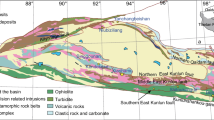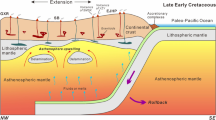Abstract
The Neoproterozoic Dokhan volcanics of the Fatira area in eastern Egypt comprise two main rock suites: (a) an intermediate volcanic suite, consisting of basaltic andesite, andesite, dacite, and their associated pyroclastic rocks; and (b) a felsic volcanic suite composed of rhyolite and rhyolitic tuffs. The two suites display well-defined major and trace element trends and a continuum in composition with wide ranges in SiO2 (54–76%), CaO (8.19–0.14%), MgO (6.96–0.04%), Sr (983–7 ppm), Zr (328–95 ppm), Cr (297–1 ppm), and Ni (72–1 ppm). They are enriched in LILEs (Rb, Ba, K, Th, Ce) relative to high field strength elements (Nb, Zr, P, Ti) and show strong affinity to calc-alkaline subduction-related rocks. However, their undeformed character, their emplacement temporally and spatially with post-orogenic A-type granite, and their high Zr/Y values suggest that their emplacement follow the cessation of subduction in eastern Egypt in an extensional-related within-plate setting. Major and trace element variations in the intermediate volcanics are consistent with their formation via partial melting of an enriched subcontinental lithospheric mantle source followed by a limited low-pressure fractional crystallization of olivine and pyroxene before emplacement. The LILE enrichment relative to HFSE is attributed to the inheritance of a subduction component from mantle material which constituted the mantle wedge during previous subduction events in eastern Egypt. The evolution of the whole volcanic spectrum was governed mainly by crystal/melt fractionation of amphibole, plagioclase, titanomagnetite, and apatite in the intermediate varieties and plagioclase, amphibole, biotite, Fe–Ti oxides, apatite, and zircon in the felsic varieties. At each stage of evolution, crystal fractionation was accompanied by variable degrees of crustal contamination.
Similar content being viewed by others
Author information
Authors and Affiliations
Additional information
Received: 28 June 1998 / Accepted: 25 August 1999
Rights and permissions
About this article
Cite this article
Mohamed, F., Moghazi, A. & Hassanen, M. Geochemistry, petrogenesis and tectonic setting of late Neoproterozoic Dokhan-type volcanic rocks in the Fatira area, eastern Egypt. Int Journ Earth Sciences 88, 764–777 (2000). https://doi.org/10.1007/s005310050304
Issue Date:
DOI: https://doi.org/10.1007/s005310050304




